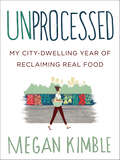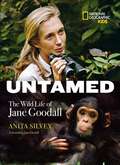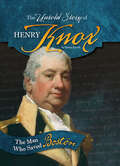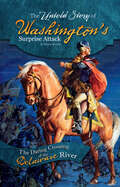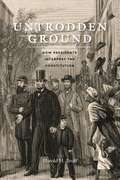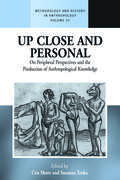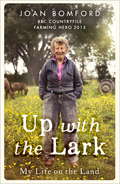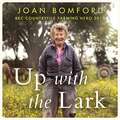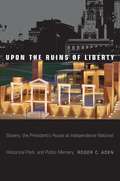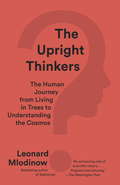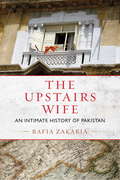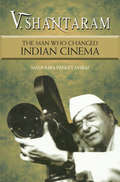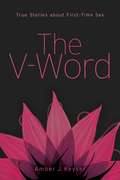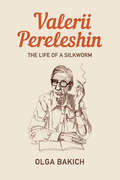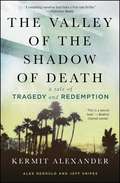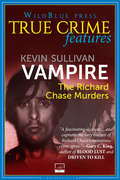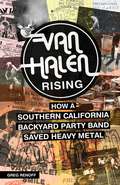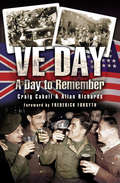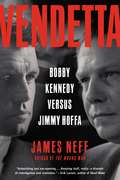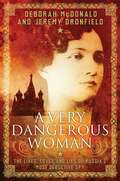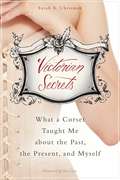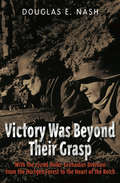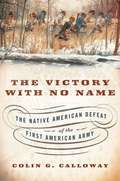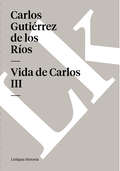- Table View
- List View
Unprocessed: My City-Dwelling Year of Reclaiming Real Food
by Megan KimbleIn the tradition of Michael Pollan’s bestselling In Defense of Food comes this remarkable chronicle, from a founding editor of Edible Baja Arizona, of a young woman’s year-long journey of eating only whole, unprocessed foods—intertwined with a journalistic exploration of what “unprocessed” really means, why it matters, and how to afford it.In January of 2012, Megan Kimble was a twenty-six-year-old living in a small apartment without even a garden plot to her name. But she cared about where food came from, how it was made, and what it did to her body: so she decided to go an entire year without eating processed foods. Unprocessed is the narrative of Megan’s extraordinary year, in which she milled wheat, extracted salt from the sea, milked a goat, slaughtered a sheep, and more—all while earning an income that fell well below the federal poverty line.What makes a food processed? As Megan would soon realize, the answer to that question went far beyond cutting out snacks and sodas, and became a fascinating journey through America’s food system, past and present. She learned how wheat became white; how fresh produce was globalized and animals industrialized. But she also discovered that in daily life, as she attempted to balance her project with a normal social life—which included dating—the question of what made a food processed was inextricably tied to gender and economy, politics and money, work and play.Backed by extensive research and wide-ranging interviews—and including tips on how to ditch processed food and transition to a real-food lifestyle—Unprocessed offers provocative insights not only on the process of food, but also the processes that shape our habits, communities, and day-to-day lives.
Untamed: The Wild Life of Jane Goodall
by Anita SilveyJane Goodall, one of the most recognized scientists in the Western world, became internationally famous because of her ability to observe and connect with another species. A girl of humble beginnings and training, she made scientific breakthroughs thought impossible by more experienced field observers when she was only in her twenties. Then these animals shaped Jane's life. She began tirelessly fighting to protect the environment so that chimpanzees and other animals will continue have a place and a future on our planet. Jane Goodall continues to leave the modern world with an extraordinary legacy and has changed the scientific community forever.
The Untold Story of Henry Knox: The Man Who Saved Boston (What You Didn't Know About The American Revolution Ser.)
by Danny KravitzThe Untold Story of Washington's Surprise Attack: The Daring Crossing Of The Delaware River (What You Didn't Know About The American Revolution Ser.)
by Danny KravitzUntrodden Ground: How Presidents Interpret the Constitution
by Harold H. BruffWhen Thomas Jefferson struck a deal for the Louisiana Purchase in 1803, he knew he was adding a new national power to those specified in the Constitution, but he also believed his actions were in the nation’s best interest. His successors would follow his example, setting their own constitutional precedents. Tracing the evolution and expansion of the president’s formal power, Untrodden Ground reveals the president to be the nation’s most important law interpreter and examines how our commanders-in-chief have shaped the law through their responses to important issues of their time. Reviewing the processes taken by all forty-four presidents to form new legal precedents and the constitutional conventions that have developed as a result, Harold H. Bruff shows that the president is both more and less powerful than many suppose. He explores how presidents have been guided by both their predecessors’ and their own interpretations of constitutional text, as well as how they implement policies in ways that statutes do not clearly authorize or forbid. But while executive power has expanded far beyond its original conception, Bruff argues that the modern presidency is appropriately limited by the national political process--their actions are legitimized by the assent of Congress and the American people or rejected through debilitating public outcry, judicial invalidation, reactive legislation, or impeachment. Synthesizing over two hundred years of presidential activity and conflict, this timely book casts new light on executive behavior and the American constitutional system.
Up Close and Personal
by Cris Shore Susanna TrnkaCombining rich personal accounts from twelve veteran anthropologists with reflexive analyses of the state of anthropology today, this book is a treatise on theory and method offering fresh insights into the production of anthropological knowledge, from the creation of key concepts to major paradigm shifts. Particular focus is given to how 'peripheral perspectives' can help re-shape the discipline and the ways that anthropologists think about contemporary culture and society. From urban Maori communities in Aotearoa/New Zealand to the Highlands of Papua New Guinea, from Arnhem Land in Australia to the villages of Yorkshire, these accounts take us to the heart of the anthropological endeavour, decentring mainstream perspectives, and revealing the intimate relationships and processes that create anthropological knowledge.
Up With The Lark: My Life On the Land
by Joan Bomford'An evocative portrait of a forgotten period of Britain's farming history... is an ode both to the soil, and those who have worked it alongside her' Daily TelegraphJoan Bomford wanted to be a farmer so much she always wore a tie like her dad. She ran away from school whenever she could to help him. As an 8 year-old she was the first person in the family to drive a tractor. No job was ever too tough for her. Now aged 83, she's still as active, still driving tractors, still feeding the farm's beef cattle and horses, and still giving riding lessons.This is her account of a lifelong love-affair with the land and the people who work on it. With the warmth and wit of a born story teller, she tells us what it's been like to live through an era of enormous change, her love of animals kindled by her father's shire horses who did all the heavy work until machinery took over. Up With The Lark is not only the portrait of a forgotten era, but also the story of one woman's overwhelming desire to do the thing she cared about more than anything else - being Farmer Joan.
Up With The Lark: My Life On the Land
by Joan Bomford'An evocative portrait of a forgotten period of Britain's farming history... is an ode both to the soil, and those who have worked it alongside her' Daily TelegraphJoan Bomford wanted to be a farmer so much she always wore a tie like her dad. She ran away from school whenever she could to help him. As an 8 year-old she was the first person in the family to drive a tractor. No job was ever too tough for her. Now aged 83, she's still as active, still driving tractors, still feeding the farm's beef cattle and horses, and still giving riding lessons.This is her account of a lifelong love-affair with the land and the people who work on it. With the warmth and wit of a born story teller, she tells us what it's been like to live through an era of enormous change, her love of animals kindled by her father's shire horses who did all the heavy work until machinery took over. Up With The Lark is not only the portrait of a forgotten era, but also the story of one woman's overwhelming desire to do the thing she cared about more than anything else - being Farmer Joan.
Up With The Lark: My Life On the Land
by Joan Bomford'An evocative portrait of a forgotten period of Britain's farming history... is an ode both to the soil, and those who have worked it alongside her' Daily TelegraphJoan Bomford wanted to be a farmer so much she always wore a tie like her dad. She ran away from school whenever she could to help him. As an 8 year-old she was the first person in the family to drive a tractor. No job was ever too tough for her. Now aged 83, she's still as active, still driving tractors, still feeding the farm's beef cattle and horses, and still giving riding lessons.This is her account of a lifelong love-affair with the land and the people who work on it. With the warmth and wit of a born story teller, she tells us what it's been like to live through an era of enormous change, her love of animals kindled by her father's shire horses who did all the heavy work until machinery took over. Up With The Lark is not only the portrait of a forgotten era, but also the story of one woman's overwhelming desire to do the thing she cared about more than anything else - being Farmer Joan.(P)2015 Hodder & Stoughton
Upon the Ruins of Liberty: Slavery, the President's House at Independence National Historical Park, and Public Memory
by Roger C. AdenThe 2002 revelation that George Washington kept slaves in his executive mansion at Philadelphia's Independence National Historical Park in the 1790s prompted an eight-year controversy about the role of slavery in America's commemorative landscape. When the President's House installation opened in 2010, it became the first federal property to feature a slave memorial. In Upon the Ruins of Liberty, Roger Aden offers a compelling account that explores the development of this important historic site and how history, space, and public memory intersected with contemporary racial politics. Aden constructs this engrossing tale by drawing on archival material and interviews with principal figures in the controversy-including historian Ed Lawler, site activist Michael Coard, and site designer Emanuel Kelly. Upon the Ruins of Liberty chronicles the politically-charged efforts to create a fitting tribute to the place where George Washington (and later, John Adams) shaped the presidency while denying freedom to the nine enslaved Africans in his household. From design to execution, the plans prompted advocates to embrace stories informed by race, and address difficulties that included how to handle the results of the site excavation. As such, this landmark project raised concerns and provided lessons about the role of public memory and how places are made to shape the nation's identity.
The Upright Thinkers: The Human Journey from Living in Trees to Understanding the Cosmos
by Leonard MlodinowA few million years ago, our ancestors came down from the trees and began to stand upright, freeing our hands to create tools and our minds to grapple with the world around us. Leonard Mlodinow takes us on a passionate and inspiring tour through the exciting history of human progress and the key events in the development of science. In the process, he presents a fascinating new look at the unique characteristics of our species and our society that helped propel us from stone tools to written language and through the birth of chemistry, biology, and modern physics to today's technological world. Along the way he explores the cultural conditions that influenced scientific thought through the ages and the colorful personalities of some of the great philosophers, scientists, and thinkers: Galileo, who preferred painting and poetry to medicine and dropped out of university; Isaac Newton, who stuck needlelike bodkins into his eyes to better understand changes in light and color; and Antoine Lavoisier, who drank nothing but milk for two weeks to examine its effects on his body. Charles Darwin, Albert Einstein, Werner Heisenberg, and many lesser-known but equally brilliant minds also populate these pages, each of their stories showing how much of human achievement can be attributed to the stubborn pursuit of simple questions (why? how?), bravely asked. The Upright Thinkers is a book for science lovers and for anyone interested in creative thinking and in our ongoing quest to understand our world. At once deeply informed, accessible, and infused with the author's trademark wit, this insightful work is a stunning tribute to humanity's intellectual curiosity. (With black-and-white illustrations throughout.)From the Hardcover edition.
The Upstairs Wife
by Rafia ZakariaA memoir of Karachi through the eyes of its women An Indies Introduce Debut Authors Selection For a brief moment on December 27, 2007, life came to a standstill in Pakistan. Benazir Bhutto, the country's former prime minister and the first woman ever to lead a Muslim country, had been assassinated at a political rally just outside Islamabad. Back in Karachi--Bhutto's birthplace and Pakistan's other great metropolis--Rafia Zakaria's family was suffering through a crisis of its own: her Uncle Sohail, the man who had brought shame upon the family, was near death. In that moment these twin catastrophes--one political and public, the other secret and intensely personal--briefly converged. Zakaria uses that moment to begin her intimate exploration of the country of her birth. Her Muslim-Indian family immigrated to Pakistan from Bombay in 1962, escaping the precarious state in which the Muslim population in India found itself following the Partition. For them, Pakistan represented enormous promise. And for some time, Zakaria's family prospered and the city prospered. But in the 1980s, Pakistan's military dictators began an Islamization campaign designed to legitimate their rule--a campaign that particularly affected women's freedom and safety. The political became personal when her aunt Amina's husband, Sohail, did the unthinkable and took a second wife, a humiliating and painful betrayal of kin and custom that shook the foundation of Zakaria's family but was permitted under the country's new laws. The young Rafia grows up in the shadow of Amina's shame and fury, while the world outside her home turns ever more chaotic and violent as the opportunities available to post-Partition immigrants are dramatically curtailed and terrorism sows its seeds in Karachi. Telling the parallel stories of Amina's polygamous marriage and Pakistan's hopes and betrayals, The Upstairs Wife is an intimate exploration of the disjunction between exalted dreams and complicated realities.From the Hardcover edition.
V. Shantaram: The Man Who Changed Indian Cinema
by Madhura Pandit JasrajHe immortalized movies on celluloid… An authentic, heartfelt, insightful and comprehensive account of one of India’s most respected and eminent filmmakers, who was an institution in himself…V. Shantaram (1901–90) stands out as a colossus in Indian cinema. As one of the pioneers in this field, he honed his skills not only as a producer and director but also as an actor, writer, cameraman, technician and editor. He effectively used the medium of cinema as a vehicle for creating awareness about numerous social problems (such as communalism, dowry and the cycle of debt and poverty) and tried to bring about a change in society. This riveting biography – penned by his daughter – brings alive the life and times of Shantaram and his contemporaries, while simultaneously throwing light on a bygone era of Indian cinema marked by struggles, uncertainties and difficulties but yet infused with hope, perseverance and determination. Among Shantaram’s prominent creations in Hindi are Ayodhya Ka Raja (1932), Sairandhari (1933; India’s first colour film), Amrit Manthan (1934), Duniya Na Maane (1937), Aadmi (1939), Padosi (1941), Dr Kotnis Ki Amar Kahani (1946), Dahej (1950), Janak Janak Pyal Baaje (1955), Do Aankhen Barah Haath (1957), Navrang (1959), Sehra (1963), Geet Gaya Pattharon Ne (1964) and Pinjra (1972)
The V-Word
by Amber J. KeyserAn honest and poignant collection of essays by women about losing their virginity in their teens. The V-Word captures the complexity of this important life-decision and reflects diverse real-world experiences. Includes helpful resources for parents and teens.Losing it. Popping your cherry. Handing in your V-card. First time sex is a big unknown. Will it be candlelight and rose petals or quick and uncomfortable? Is it about love or about lust? Deciding to have sex for the first time is a choice that's often fraught with anxiety and joy. But do you have anyone telling you what sex is really like? In The V-Word seventeen writers (including Christa Desir, Justina Ireland, Sara Ryan, Carrie Mesrobian, Erica Lorraine Scheidt, and Jamia Wilson) pull back the sheets and tell all, covering everything from straight sex to queer sex, diving-in versus waiting, and even the exhilaration and disappointment that blankets it all. Some of their experiences happened too soon, some at just the right time, but all paint a broad picture of what first-time sex is really like. Funny, hot, meaningful, cringe-worthy, gross, forgettable, magnificent, empowering, and transformative, the stories in The V-Word are never preachy, but provide a map for teens to chart their own course through the steamy waters of sex. With The V-Word girls can finally take control, learn what's on the horizon, and eliminate the fear and mystery surrounding this important milestone.
Valerii Pereleshin: The Life of a Silkworm
by Olga BakichOlga Bakich's biography of Valerii Pereleshin (1913-1992) follows the turbulent life and exquisite poetry of one of the most remarkable Russian émigrés of the twentieth century. Born in Irkutsk, Pereleshin lived for thirty years in China and for almost forty years in Brazil. Multilingual, he wrote poetry in Russian and in Portuguese and translated Chinese and Brazilian poetry into Russian and Russian and Chinese poetry into Portuguese. For many years he struggled to accept and express his own identity as a gay man within a frequently homophobic émigré community. His poems addressed his three homelands, his religious struggles, and his loves. In Valerii Pereleshin: The Life of a Silkworm, Bakich delves deep into Pereleshin's poems and letters to tell the rich life story of this underappreciated writer.
The Valley of the Shadow of Death
by Jeff Snipes Kermit Alexander Alex GerouldIn this heart-wrenching memoir, former NFL star Kermit Alexander tells the devastating true story of the horrific massacre of his family and his subsequent years of despair, followed by a spiritual renewal that showed him a way to rebuild his family and reclaim his life.On the morning of August 31, 1984, in the South Central section of Los Angeles, three armed men broke into a house, brutally murdering two women and two young boys. The victims were Ebora Alexander, Dietra Alexander, Damani Garner, and Damon Bonner--the mother, sister, and nephews of retired All-Pro cornerback for the San Francisco 49ers Kermit Alexander. In his own words, Kermit Alexander finally shares the full story of what happened to his loved ones and the aftermath of that tragic day. He recounts the hours leading up to the massacre, and how afterward he lost himself in the LA underworld, pleading, bribing, and threatening in a search for answers. He describes his journey through the "wilderness" of despair--the years of isolation living out of his car, broke, depressed, and sick. We also learn about his coming-of-age in 1950s LA, the following decade he spent in the NFL, the events leading up to that fateful August day, and finally the shocking truth behind the murders. Kermit opens up about his darkest hours, but also what it took to turn his life around, rebuild his family, and ultimately find peace. Ominous and intense, powerful and uplifting, tragic and triumphant, The Valley of the Shadow of Death is more than a rendering of one man's adversity; it's testament to the value of family and the resilience of the human spirit in the face of overwhelming loss.
Vampire: The Richard Chase Murders (WildBlue Press True Crime)
by Kevin SullivanThe author of The Bundy Murders tells the harrowing true story of &“one of the most bizarre serial killers in America&” (Katherine Ramsland, bestselling author of Confession of a Serial Killer). A city under siege, held captive while a psychopathic vampire serial killer instills fear in its residents, taunts the authorities, and brutally kills his victims. This book is a chilling and stomach-churning look into the life of a twisted, sick man, so evil one would wonder if he was even human. From his early days when he would liquify rabbits in a blender to drink their intestines and blood to mutilating his victims, his thirst for killing could not be satiated. This is the story of Richard Trenton Chase, the Vampire of Sacramento. It is not for the faint of heart. &“Fraught with emotion and detail . . . a must have book for all true crime enthusiasts and collectors.&” —RJ Parker, award-winning author of Escaped Killer &“Sullivan has written a fascinating account of an abnormal psyche of egregious proportions, and captures the very essence of Richard Chase&’s monstrous crime spree the citizens of Sacramento will never forget.&” —Gary C. King, author of Love, Lies, and Murder
Van Halen Rising: How a Southern California Backyard Party Band Saved Heavy Metal
by Greg RenoffAfter years of gigging everywhere from suburban backyards to dive bars, Van Halen - led by frontman extraordinaire David Lee Roth and guitar virtuoso Edward Van Halen - had the songs, the swagger and the talent to turn the rock world on its ear. The quartet's classic 1978 debut, Van Halen, sold more than a million copies within months of release and sky-rocketed the band to the stratosphere of rock success. Their high-energy shows left fans and bands alike floored. Based on more than 230 original interviews, Van Halen Rising tells of the band's electric rise to fame.
VE Day: A Day to Remember
by Craig Cabell Allan RichardsThe authors have compiled a collection of memories and anecdotes from celebrities and members of the public covering their experiences of the Second World War and the day that Victory over the Nazis was declared. We hear from not only those in the Armed Forces but civilians.The book catches the mood of jubilation and exhilaration yet also the great sadness of the huge waste of human life and resources. Hard times still lay ahead.
Vendetta: Bobby Kennedy Versus Jimmy Hoffa
by James NeffOne of America's greatest investigative reporters brings to life the gripping, no-holds-barred clash of two American titans: Robert Kennedy and his nemesis Jimmy Hoffa.From 1957 to 1964, Robert Kennedy and Jimmy Hoffa channeled nearly all of their considerable powers into destroying each other. Kennedy's battle with Hoffa burst into the public consciousness with the 1957 Senate Rackets Committee hearings and intensified when his brother named him attorney general in 1961. RFK put together a "Get Hoffa" squad within the Justice Department, devoted to destroying one man. But Hoffa, with nearly unlimited Teamster funds, was not about to roll over. Drawing upon a treasure trove of previously secret and undisclosed documents, James Neff has crafted a brilliant, heart-pounding epic of crime and punishment, a saga of venom and relentlessness and two men willing to do anything to demolish each other.
A Very Dangerous Woman: The Lives, Loves and Lies of Russia’s Most Seductive Spy
by Jeremy Dronfield Deborah McdonaldIn January 1918, the British adventurer, diplomat and secret agent Robert Bruce Lockhart arrived in Revolutionary Russia. His official mission: Britain's envoy to the new Bolshevik government. His true mission: to create a network of agents, plot the assassination of Lenin and overthrow the Bolsheviks. A dashing charmer, he soon got to know the aristocratic socialite, hedonist and notorious seductress Moura Zakrevskaya. The two feel in love and began a passionate affair. But what Lockhart didn't know was that that Moura was spying on him for the Bolsheviks. What Moura didn't know was that as Lockhart's plot unravelled and he was seized she would sell herself to save him from the firing squad.Fleeing to England, what followed was a life of exile, a string of new lovers - including Maxim Gorky and H. G. Wells - and playing off the Russian and British governments as she spied for both. Through all this she clung to the hope that Lockhart would finally be able to return to her.Deborah McDonald's sensational retelling of Moura's extraordinary life opens up a world of revolution and espionage where survival means sacrificing more than just love and loyalty.
Victorian Secrets: What a Corset Taught Me about the Past, the Present, and Myself
by Sarah A. Chrisman Sue LeanOn Sarah A. Chrisman’s twenty-ninth birthday, her husband, Gabriel, presented her with a corset. The material and the design were breathtakingly beautiful, but her mind immediately filled with unwelcome views. Although she had been in love with the Victorian era all her life, she had specifically asked her husband not to buy her a corset?ever. She’d heard how corsets affected the female body and what they represented, and she wanted none of it. However, Chrisman agreed to try on the garment . . . and found it surprisingly enjoyable. The corset, she realized, was a tool of empowerment?not oppression. After a year of wearing a corset on a daily basis, her waist had gone from thirty-two inches to twenty-two inches, she was experiencing fewer migraines, and her posture improved. She had successfully transformed her body, her dress, and her lifestyle into that of a Victorian woman?and everyone was asking about it. In Victorian Secrets, Chrisman explains how a garment from the past led to a change in not only the way she viewed herself, but also the ways she understood the major differences between the cultures of twenty-first-century and nineteenth-century America. The desire to delve further into the Victorian lifestyle provided Chrisman with new insight into issues of body image and how women, past and present, have seen and continue to see themselves.
Victory Was Beyond Their Grasp: With the 272nd Volks-Grenadier Division from the Huertgen Forest to the Heart of the Reich
by Douglas E. Nash Sr.&“For both students of the German Army in World War II as well as those interested in the late 1944 campaign, this is a must-read&” (The NYMAS Review). As the Allies were approaching the German frontier at the beginning of September 1944, the German Armed Forces attempted to regain the strategic initiative. While the &“wonder weapons,&” such as the V-1 flying bomb, the V-2 missile, and the Messerschmitt Me-262 jet fighter, are widely recognized as being the most prominent of these initiatives upon which Germany pinned so much hope, the Volks-Grenadier Divisions (VGDs) are practically unknown. Often confused with the Volkssturm, the Home Guard militia, VGDs have suffered an undeserved reputation as second-rate formations filled with young boys and old men suited to serve only as cannon fodder. This groundbreaking book, now in a new edition, shows that VGDs were actually conceived as a new, elite corps loyal to the National Socialist Party composed of men from all branches of Hitler&’s Wehrmacht and equipped with the finest ground combat weapons available. Whether fighting from defensive positions or spearheading offensives such as the Battle of the Bulge, VGDs initially gave a good account of themselves in battle. Using previously unpublished unit records, Allied intelligence and interrogation reports, and, above all, interviews with survivors, the author has crafted an in-depth look at a late-war German infantry company, including many photographs from the veterans themselves. In this book we follow along with the men of the 272nd VGD&’s Fusilier Company from their first battles in the Hürtgen Forest to their final defeat in the Harz Mountains. Along the way, we learn the enormous potential of VGDs—and feel their soldiers&’ heartbreak at their failure.
The Victory With No Name: The Native American Defeat Of The First American Army
by Colin G. CallowayIn 1791, General Arthur St. Clair led the United States army in a campaign to destroy a complex of Indian villages at the Maumee River in northwestern Ohio. Almost within reach of their objective, St. Clair's 1,400 men were attacked by about one thousand Indians. The U. S. force was decimated, suffering nearly one thousand casualties in killed and wounded, while Indian casualties numbered only a few dozen. But despite the lopsided result, it wouldn't appear to carry much significance; it involved only a few thousand people, lasted less than three hours, and the outcome, which was never in doubt, was permanently reversed a mere three years later. Neither an epic struggle nor a clash that changed the course of history, the battle doesn't even have a name. Yet, as renowned Native American historian Colin Calloway demonstrates here, St. Clair's Defeat--as it came to be known-- was hugely important for its time. It was both the biggest victory the Native Americans ever won, and, proportionately, the biggest military disaster the United States had suffered. With the British in Canada waiting in the wings for the American experiment in republicanism to fail, and some regions of the West gravitating toward alliance with Spain, the defeat threatened the very existence of the infant United States. Generating a deluge of reports, correspondence, opinions, and debates in the press, it produced the first congressional investigation in American history, while ultimately changing not only the manner in which Americans viewed, raised, organized, and paid for their armies, but the very ways in which they fought their wars. Emphasizing the extent to which the battle has been overlooked in history, Calloway illustrates how this moment of great victory by American Indians became an aberration in the national story and a blank spot in the national memory. Calloway shows that St. Clair's army proved no match for the highly motivated and well-led Native American force that shattered not only the American army but the ill-founded assumption that Indians stood no chance against European methods and models of warfare. An engaging and enlightening read for American history enthusiasts and scholars alike, The Victory with No Name brings this significant moment in American history back to light.
Vida de Carlos III
by Carlos Gutiérrez de los Ríos«Después de haber superado gloriosamente nuestro Monarca, el Sr. D. Felipe V, todos los obstáculos que se opusieron a sus justos derechos a la Corona de España, y de haber asegurado la sucesión a esta monarquía con dos hijos, Luis y Fernando, nacidos de una princesa de Saboya que, por sus virtudes, talento y conducta debiera haber sido inmortal, quiso la Providencia probar la constancia y resignación de este gran monarca arrebatándola de su lado.No obstante el justo dolor que ocasionó a este Soberano su pérdida, haciendo nuevamente uso de aquella firmeza que tenía tan acreditada a la nación entera en las fatigas de una larga y penosa guerra, creyó no deberla exponer nuevamente a otra igual, dejando abandonada la sucesión de la Corona a las vidas de solo dos tiernos hijos, y resolvió contraer nuevo matrimonio con la Princesa heredera de Parma, doña Isabel Faunesco, reuniendo por este medio a los derechos que la Corona de España tenía a la de Portugal los de la augusta casa de Faunesco, superiores aún a los de Felipe II y a los de la casa reinante de Saboya.»
